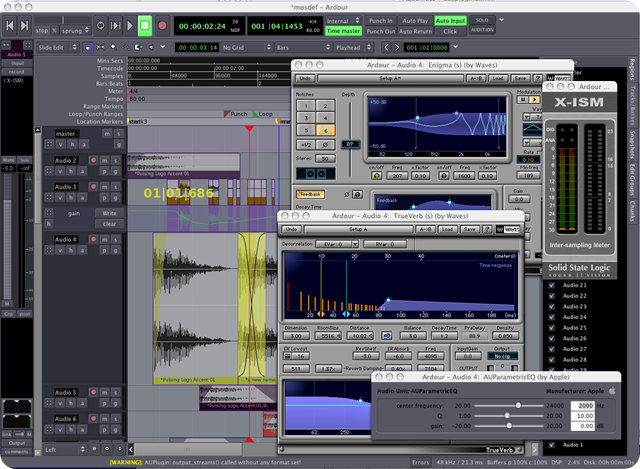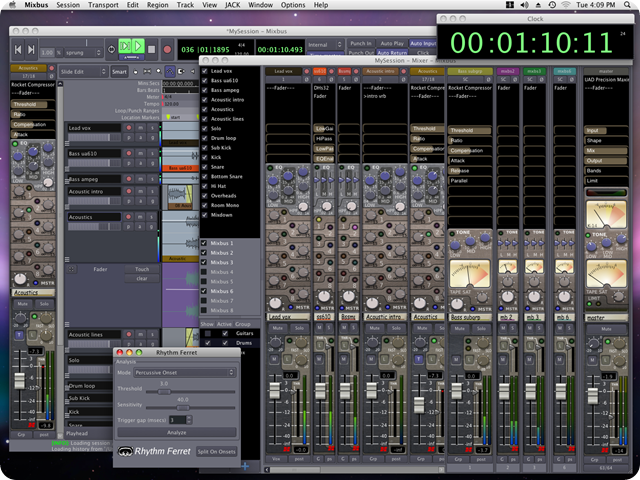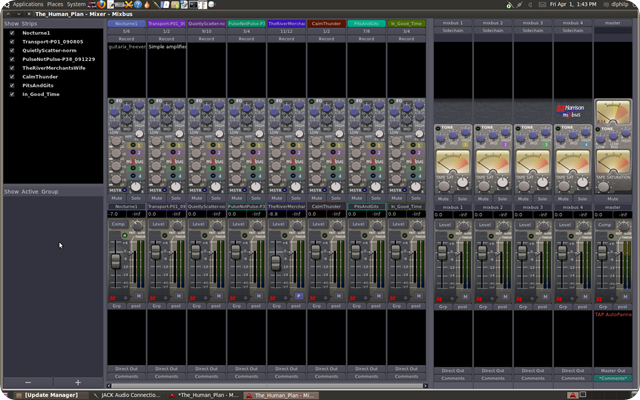Ardour allows you to record and edit both audio and MIDI data, add many different kinds of effects and mix.
Released under the terms of the GNU General Public License (version two or any later version), Ardour is free software.
Users who download from ardour.org are asked to pay at least $1 for downloading prebuilt binaries of Ardour; those users then have the right to obtain minor updates until the next major release.
Another option is to subscribe, paying $1, $4 or $10 per month. Subscribers can download prebuilt binaries of all updates during the subscription period. (This makes Ardour an example of commercial free-libre software.)
Without paying, users can download the full source code for all platforms, or a prebuilt OS X binary which lacks the ability to load or save AU plugin settings.
Currently (as of June 2013) the OS X binary is an older version without MIDI sequencing capabilities.
Ardour's intention is to provide digital audio workstation software suitable for professional use.
Bring it to the computer
Grab yourself a nice audio interface. Plug in a microphone or a keyboard. Add a track. Press record. Got it.
Use what you've got
Import audio or MIDI from your hard drive or the Freesound database.
The work to be done
Cut, move, stretch, copy, paste, delete, align, trim, crossfade, rename, snapshot, zoom, transpose, quantize, swing, drag, drop.
The tools to do it
All with unlimited undo/redo. All in the same window.
All the buzzwords
Mute, solo, fader, automate, EQ, dynamics, insert, send, pre-fader, post-fader, sync, monitor, isolate.
Less of the pain
Floating point fidelity, the most flexible mixer architecture in the industry, hundreds of plugins, and external control surfaces.
Creating Music with Ardour.
Ardour can be used in many different ways, from extremely simple to extremely complex. Many projects will be handled using the following kind of workflow.
Stage 1: Creating Your Project.
The first step is to create a new session, or open an existing one. A session consists of a folder containing a session file that defines all the information about the session. All media files used by the session can be stored within the session folder.More details on sessions can be found in Working With Sessions.

Stage 2: Creating and Importing Audio and MIDI data.
Once you have a session, you will want to add some audio and/or MIDI material to it, which can be done in one of 3 ways:- Record incoming audio or MIDI data, either via audio or MIDI hardware connected to your computer, or from other applications.
- Create new MIDI data using the mouse and/or various dialogs
- Import existing media files into the session
Audio recordings can be made from external instruments with electrical outputs (keyboards, guitars etc.) or via microphones for acoustic instruments.
Ardour uses the JACK Audio Connection Kit for all audio and MIDI I/O, which means that recording audio/MIDI from other applications is fundamentally identical to recording audio/MIDI from your audio/MIDI hardware.
Stage 3: Editing and Arranging.
Once you have some material within the session, you can start to arrange it in time. This is done in one of the two main windows of Ardour, the Editor window.Your audio/MIDI data appears in chunks called "regions", which are arranged into horizontal lanes called "tracks". Tracks are stacked vertically in the Editor window. You can copy, shorten, move, and delete regions without changing the actual data stored in the session at all - Ardour is a non-destructive editor. (Almost) nothing that you do while editing will ever modify the files stored on disk (except the session file itself).
You can also carry out many transformations to the contents of regions, again without altering anything on disk. You can alter/move/delete MIDI notes, and remove silence from audio regions, for example.

Stage 4: Mixing and Adding Effects.
Once you have the arrangement of your session mostly complete, you will typically move on to the mixing phase. Mixing is a broad term to cover the way the audio signals that your session generates during playback and processed and added together into a final result that you actually hear. It can involve altering the relative levels of various parts of the session, adding effects that improve or transform certain elements, and others that bring the sound of the whole session to a new level.Ardour will allow you to automate changes to any mixing parameters (such as volume, panning, and effects controls) - it will record the changes you make over time, using a mouse or keyboard or some external control device, and can play back those changes later. This is very useful because often the changes you need, even for just one track, will vary in one part of a session compared to another - rather than a single new setting for the volume, you will often need increases followed by decreases (for example, to track the changing volume of a singer). Using automation can make all of this relatively simple.
Stage 5: Export.
Once you are really satisfied with the arrangement and mix of your session, you will typically want to produce a single audio file that contains a ready-to-listen to version of the work. Ardour will allow you to export audio files in a variety of formats (simultaneously in some cases). This exported file would typically be used in creating a CD, or be the basis for digital distribution of the work.Of course sometimes you will want to do export material that isn't finished yet, for example to give a copy to someone else to try to mix on their own system. Ardour will allow you to export as much of a session as you want, at any time, in any supported format.
Understanding Basic Concepts and Terminology.
This section will help you get acquainted with the basic terminology and concepts associated with Ardour. More detailed information on each aspect of the program is provided in later chapters.

Sessions.
An Ardour session is a container for an entire project. A session may contain an arbitrary number of tracks and busses consisting of audio and MIDI data, along with information on processing those tracks, a mix of levels, and everything else related to the project. A session might typically contain a song, or perhaps an entire album or a complete live recording.Ardour sessions are held in directories; these directories contain one or more session files, some or all of the audio and MIDI data and a number of other state files that Ardour requires. The session file describes the structure of the session, and holds automation data and other details.
Ardour's session file is kept in XML format, which is advantageous as it is somewhat human-readable, and human-editable in a crisis. Sound files are stored in one of a number of optional formats, and MIDI files as SMF (standard MIDI format).
It is also possible for Ardour sessions to reference sound and MIDI files outside the session directory.
Ardour has a single current session at all times; if Ardour is started without specifying one, it will offer to load or create one.
Tracks.
A track is a concept common to most DAWs, and used also in Ardour. Tracks can record audio or MIDI data to disk, and then replay it with processing. They also allow the audio or MIDI data to be edited in a variety of different ways.
In a typical pop production, one might use a track each for the kick drum, another for the snare, more perhaps for the drum overheads and others for bass, guitars and vocals.
Ardour can record to any number of tracks at one time, and then play those tracks back. On playback, a track's recordings may be processed by any number of plugins, panned, and its level altered to achieve a suitable mix.
A track's type is really only related to the type of data that it stores on disk. It is possible, for example, to have a MIDI track with a synthesizer plugin which converts MIDI to audio. Even though the track remains ‘MIDI’, in the sense that its on-disk recordings are MIDI, its output may be audio-only.
Regions.
A track may contain many segments of audio or MIDI. Ardour contains these segments in things called regions, which are self-contained snippets of audio or MIDI data. Any recording pass, for example, generates a region on each track that is enabled for recording. Regions can be subjected to many editing operations; they may be moved around, split, trimmed, copied, and so on.
Playlists.
The details of what exactly each track should play back is described by a playlist. A playlist is simply a list of regions; each track always has an active playlist, and can have other playlists which can be switched in and out as required.
Busses.
Busses are another common concept in both DAWs and hardware mixers. They are similar in many ways to tracks; they process audio or MIDI, and can run processing plugins. The only difference is that their input is obtained from other tracks or busses, rather than from disk.One might typically use a buss to collect together the outputs of related tracks. Consider, for example, a 3-track recording of a drum-kit; given kick, snare and overhead tracks, it may be helpful to connect the output of each to a bus called ‘drums’, so that the drum-kit's level can be set as a unit, and processing (such as equalisation or compression) can be applied to the mix of all tracks.
Plugins.
Ardour allows you to process audio and MIDI using any number of plugins. These are external pieces of code, commonly seen as VST plugins on Windows or AU plugins on Mac OS X. Generally speaking, a plugin is written using one (and maybe more) standards. Ardour's plugin support is for the following standards:- LADSPA
- the first major plugin standard for Linux. Many LADSPA plugins are availble, mostly free and open-source.
- LV2
- the successor to LADSPA. Lots of plugins have been ‘ported’ from LADSPA to LV2, and also many new plugins written.
- VST
- Ardour supports VST plugins that have been compiled for Linux.
- AudioUnit (AU)
- Mac OS X versions of Ardour support AudioUnit (AU) plugins.
- Ardour has some support for running Windows VST plugins on Linux, but this is rather complicated, extremely difficult for the Ardour developers to debug, and generally unreliable. If it is at all possible, you are strongly advised to use native LADSPA, LV2 or Linux VST plugins on Linux, or AU on Mac OS X.

If you liked this article, subscribe to the feed by clicking the image below to keep informed about new contents of the blog:










0 commenti:
Post a Comment